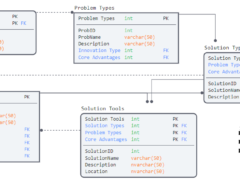Identifying the pricing model for your business’ products and services can be crucial. It is one of the most important items in your business plan. This is because the pricing model is interdependent with other business areas. These other areas influence your business’s cost, opportunities, and risks in providing its products and services.
Not considering these overlapping domains and functions while building a pricing model can be risky. It can result in lost opportunities at best. At worst, it can lead to lost customers and business. Building a pricing model that considers these relationships can strengthen your business model. It can also create a potential competitive advantage in the market. Additional competitive advantages can be obtained by evaluating each of the overlapping domains, functions, and competencies. Look for opportunities to increase efficiency. Seek ways to boost productivity and improve quality.

The domains that should be included in your business’ efforts to build a pricing model will depend on its product offerings. They will also depend on service offerings. They will also depend on the market & industry and the business’ unique goals. The pricing models used to build growth in a new market may be different. They vary from those used in an existing and competitive market. The former may emphasize premium pricing for solutions not found in the marketplace. The latter may focus on pursuing cost leadership to undermine existing competitors.
The business’ pricing model and goals are not determined in isolation of the market. They are developed with an understanding of the business environment. This includes both internal and external factors that can influence the business’ success. The following Pricing Model Canvas includes four domains. These need development for the business to be successful. Building out these four domains cannot fix bad services or poorly designed products. However, it can help the business build a pricing model aligned with the business’ market & industry opportunities.
Domain #1: Market Research
Market research is essential to understanding the business industry and market opportunities. It helps in identifying customer problems. Additionally, it shows how your business offerings compare to competitor’s products and services. Market research also highlights areas for growth. The best market research focuses on unique market opportunities. It assesses threats for each unique product or service offering of the business.
Domain #2: Competitive Advantage
Identifying the business’ competitive advantage is essential to building the brand, activating new customers, and expanding market share. The competitive advantage can be achieved in product/service costs (internal & external), differentiation from competitor’s offerings (better quality, etc.), includes strategies that limit competitors ability to offer the same product/services, or alliances that help expand on the continuum of product/services ‘values’ offered. The business can emphasize one of these areas or pursue all of them (and more) across their different product/service lines.
Domain #3: Business Model Value Chain
Identifying the business model is essential to consistently being able to execute the business’ strategies, plans, resources, and goals. The type of business model used depends on the business’ market and industry. It also depends on product and service offerings. Competencies and abilities are also a factor. These in turn inform the business and help it to pursue its goals within its target market and industry.
The business needs to identify its key areas. It must evaluate and strengthen these areas. They help deliver value across the business environment. The value chain will differ depending on market and industry. The following areas are often included when building a competitive pricing model. These include Marketing & Sales, Accounting, and Human Resources. They also cover Production, Logistics, Research & Development, and IT Technologies. The amount of emphasis varies for each domain. It depends on the business’ model and product or service offerings.
Domain #4: Pricing Model
As mentioned earlier the pricing model is not developed in isolation. Many overlapping factors need to be taken into consideration including the domains discussed above (Business Model Value Chain, Market Research, & Competitive Advantage, etc.) in order for the pricing model to be sustainable, relevant, and viable.

Each product/service may fall in different areas across the pricing spectrum. Typically this reflects different ‘values’ being pursued in each individual product/service’s cost (to build), delivery (includes vendors, storage, etc.), promotion (includes marketing, trade shows, print advertising, etc.), positioning (see Canvas for more details), and price (to the customer). Businesses that offer products or services across the pricing continuum often provide more advanced offerings. Quality tends to increase as the price goes up.
Higher end pricing will also typically include more functionality although this is not always the case. Some businesses use higher end pricing to position their product or service. This strategy presents the offering as a prestigious and status building item (if purchased). The pricing model available to each business will depend on its product/service offerings. It will also depend on the market and industry in which it operates.
Conclusions
There is no one-size-fits-all price model for businesses to sell their product/service offerings. Determining the price of business offerings depends on its business environment. It also depends on its offerings and the opportunities available to it. Some businesses quickly seize ‘first mover’ opportunities. Other businesses prefer to ‘wait and see’ before moving forward. These preferences affect what goals the business will pursue. They also influence what pricing models will help them get there.
Travis Barker, MPA GCPM
Innovate Vancouver is a Technology and Business Information Consulting Service (TBICS) located in Vancouver, BC. Contact Innovate Vancouver to help with your new project.
References:




